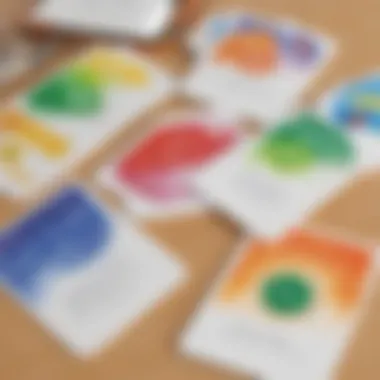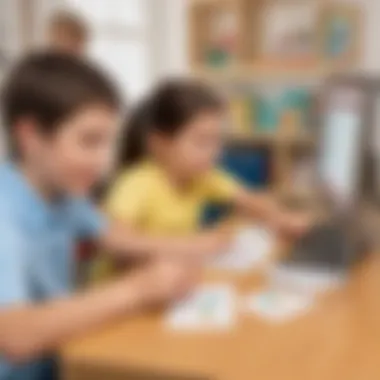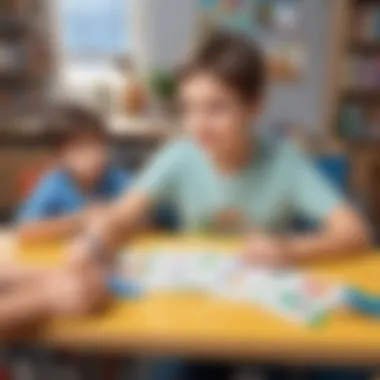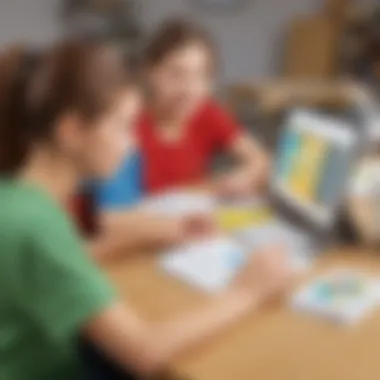Unlocking the Potential: Harnessing Programming Flash Cards for Kids


Interactive Learning Games
Programming flash cards for kids offer a unique avenue for interactive learning, especially for children between the ages of 3 to 12. These flash cards are designed to introduce coding concepts in a simplified manner, making it fun and engaging for young learners. With a variety of interactive games available, children can explore coding principles while playing popular games that are both entertaining and educational.
Popular Games: There is a wide range of popular programming games for kids, such as 'Robot Turtles,' 'Code Master,' and 'Lightbot.' These games present coding concepts through fun challenges and puzzle-solving activities, encouraging children to think logically and strategically.
Description of Top Educational Games: Educational programming games for kids often incorporate elements of problem-solving, critical thinking, and creativity. By engaging with these games, children can develop essential cognitive skills while also fostering an interest in technology and coding.
Benefits of Playing Educational Games: Playing educational games can significantly benefit kids' cognitive development by enhancing their problem-solving abilities, logical thinking, and persistence. Through gaming, children can grasp complex concepts in a playful environment, making learning interactive and enjoyable.
Game Reviews: In-depth reviews of selected educational games provide insights into the gameplay mechanics, educational value, and overall user experience. These reviews help parents and educators understand the learning outcomes associated with each game, enabling informed decisions on integrating them into children's education.
Comparison of Gameplay and Learning Outcomes: By comparing the gameplay features and learning outcomes of different educational games, parents and educators can assess which games best align with their educational goals and children's learning preferences.
Introduction
Programming flash cards offer a valuable tool for enhancing children's learning experiences, especially for kids aged 3-12. By delving into the benefits, strategies, and effectiveness of incorporating flash cards into programming education, this article aims to shed light on a valuable and interactive learning approach.
Understanding the Concept of Programming Flash Cards
Definition of Programming Flash Cards
Programming flash cards are specialized tools designed to introduce children to programming concepts in a simplified and interactive manner. These flash cards contain concise information on coding principles, algorithms, and problem-solving techniques, tailored to young learners. Their key characteristic lies in breaking down complex coding concepts into digestible snippets, facilitating better comprehension and retention. This unique feature makes programming flash cards a popular choice for educators aiming to make coding more accessible to young minds.
Purpose of Using Programming Flash Cards
The purpose of using programming flash cards is to provide children with a hands-on learning experience that fosters their understanding of coding fundamentals. By utilizing these flash cards, kids can engage in interactive learning sessions that stimulate their cognitive abilities and critical thinking skills. This approach enables young learners to grasp programming concepts through visual aids and practical examples, enhancing their problem-solving and logical reasoning skills. While the advantages of programming flash cards include promoting active learning and concept reinforcement, a potential drawback could be over-reliance on memorization without full comprehension.


Importance of Programming Education for Kids
Building Logical Thinking
Programming education plays a crucial role in fostering logical thinking skills among children. By navigating through coding challenges and debugging errors, kids develop a structured approach to problem-solving. The key characteristic of this process is the cultivation of analytical thinking and sequential reasoning, essential for mastering coding languages. Building logical thinking through programming education is a popular choice for educators as it equips kids with transferrable skills applicable across various disciplines. However, a potential disadvantage could be the steep learning curve for some children due to the abstract nature of coding concepts.
Enhancing Problem-Solving Skills
Another significant aspect of programming education is its contribution to enhancing children's problem-solving skills. By immersing kids in coding tasks that require logical solutions, programming fosters a systematic approach to overcoming challenges. The key characteristic here lies in promoting resilience and creativity in tackling complex problems, crucial for academic and real-world success. Enhancing problem-solving skills is advantageous as it prepares children for future innovations and technological advancements. However, a drawback could be the risk of frustration during the learning process for some kids unfamiliar with coding principles.
Benefits of Programming Flash Cards
In this article, we delve into the significant role that programming flash cards play in enhancing children's learning experiences. When it comes to educating kids aged 3-12, integrating programming flash cards can optimize their learning potential. By exploring the benefits, strategies, and effectiveness of using flash cards in programming education, we aim to promote a valuable and interactive learning approach.
Boosting Memory Retention
Repetition in Learning
Repetition in learning is a crucial aspect when considering the effectiveness of programming flash cards for kids. With repeated exposure to information, children can enhance their memory retention capabilities, leading to better long-term learning outcomes. The key characteristic of repetition in learning lies in its ability to reinforce concepts in the young minds systematically. This repetitive learning method proves to be a popular choice in our article as it aligns with the goal of solidifying programming concepts in children. The unique feature of repetition in learning is its capacity to enhance recall and understanding, contributing significantly to the educational process.
Visual and Interactive Learning
Visual and interactive learning approaches cater well to the needs of young learners, making them essential components of programming flash cards for kids. By incorporating visual elements and interactive features, children can engage more deeply with the learning material, promoting better retention and understanding. The key characteristic of visual and interactive learning is its ability to stimulate cognitive processes and make learning more fun and engaging. This approach proves beneficial in our article as it aligns with the aim of creating an enriching learning experience for children. The unique feature of visual and interactive learning is its multi-sensory nature, which allows for a holistic understanding of programming concepts.
Enhancing Conceptual Understanding
Breaking Down Complex Concepts
Breaking down complex concepts is paramount in supporting children's conceptual understanding through programming flash cards. By simplifying intricate ideas into digestible chunks, kids can grasp challenging concepts more easily. The key characteristic of breaking down complex concepts is its effectiveness in making abstract ideas more tangible for young learners. This approach proves popular in our article as it facilitates a gradual learning progression for children. The unique feature of breaking down complex concepts is its ability to build a strong foundation of knowledge, fostering critical thinking skills among kids.


Promoting Learning Through Practice
Promoting learning through practice is a fundamental strategy integrated into programming flash cards for kids. By encouraging children to apply programming concepts in practical exercises, their skills are reinforced, leading to a deeper understanding of the subject matter. The key characteristic of promoting learning through practice is its emphasis on active engagement and hands-on learning, enabling children to internalize programming principles effectively. This approach is favored in our article as it promotes a dynamic learning environment for kids. The unique feature of promoting learning through practice is its application of theory into real-world scenarios, preparing children for practical problem-solving challenges.
Effective Strategies for Using Programming Flash Cards
Programming flash cards serve as powerful tools to enhance children's learning experiences. In this article, the focus lies on elucidating the key elements that make effective strategies for using programming flash cards indispensable in the education of kids aged 3-12. By incorporating these strategies, young learners can grasp programming concepts more efficiently, aiding in the development of logical thinking and problem-solving skills. Effective strategies for using programming flash cards revolve around engaging techniques that promote interactive and visual learning, crucial for fostering a strong foundation in programming education.
Creating Engaging Flash Cards
Utilizing Color Coding
Utilizing color coding is a fundamental aspect of creating engaging programming flash cards, offering a visually stimulating experience that enhances memory retention. The key characteristic of color coding lies in its ability to segment and categorize information, making complex concepts more digestible for young minds. This technique becomes a popular choice in this article due to its effectiveness in aiding children's comprehension and recall of programming fundamentals. The unique feature of color coding is its capacity to create associations between colors and programming concepts, resulting in a more interactive and engaging learning process.
Incorporating Pictorial Representations
Incorporating pictorial representations into programming flash cards contributes significantly to the overall goal of enhancing conceptual understanding. Pictorial representations provide visual aids that simplify abstract programming ideas, making them more accessible to children. The key characteristic of this technique is its ability to transform complex theories into relatable visuals, promoting a deeper understanding of programming concepts. This approach is a beneficial choice for this article as it caters to various learning styles and reinforces learning through visual memory. The unique feature of incorporating pictorial representations is its capacity to stimulate creativity and imagination while solidifying programming principles.
Implementing Interactive Learning
Utilizing Flash Cards in Educational Games
The incorporation of flash cards into educational games introduces a fun and engaging way to reinforce programming knowledge. By utilizing flash cards in interactive games, children are motivated to learn through play, resulting in increased attention and participation. The key characteristic of this approach is its seamless integration of entertainment and education, making learning programming concepts enjoyable for young learners. This method is a popular choice for this article as it promotes active and experiential learning, fostering a deeper understanding of programming principles. The unique feature of utilizing flash cards in educational games is its adaptability to various skill levels, catering to both beginners and advanced learners.
Group Activities and Peer Learning
Group activities and peer learning create a collaborative environment that enhances the collective understanding of programming concepts. By engaging in group activities with programming flash cards, children can exchange ideas, solve problems together, and learn from their peers. The key characteristic of this method is its promotion of teamwork and communication skills, essential for holistic development. This approach is a beneficial choice for this article as it encourages social interaction and knowledge sharing, enriching the learning experience for young programmers. The unique feature of group activities and peer learning is its ability to build confidence and foster a sense of community among young learners.
Integration of Programming Flash Cards in Curriculum


Programming Flash Cards play a crucial role in enhancing children's learning experiences within the curriculum, offering a unique approach to education for young minds between the ages of 3-12. By infusing programming concepts into everyday lessons, these flash cards introduce logical thinking and problem-solving skills in a visual and interactive manner. Their integration into the curriculum ensures a well-rounded educational experience that goes beyond traditional teaching methods.
Aligning with Academic Standards
Incorporating Flash Cards into Lesson Plans
Incorporating Programming Flash Cards into lesson plans holds a pivotal position in the educational framework, seamlessly blending theory with practical application. These flash cards are meticulously designed to simplify complex programming concepts, making them accessible to young learners. By incorporating flash cards, educators tailor lessons to accommodate various learning styles and enhance retention rates. The visual cues provided by the cards aid in concrete understanding and promote active engagement in the learning process.
Supporting Classroom Learning
Another critical aspect within the academic sphere is utilizing Programming Flash Cards to support classroom learning. These cards supplement traditional teaching methods by offering a hands-on, technology-driven approach to education. By incorporating interactive elements and encouraging participation, flash cards foster a dynamic learning environment where students can explore digital concepts in a tangible way. The integration of flash cards into classroom activities enhances student engagement and encourages collaborative learning experiences, resulting in a holistic educational journey.
Enhancing Digital Literacy
Preparing Kids for the Digital Age
Programming Flash Cards prepare children for the digital landscape by introducing essential technological concepts from an early age. By familiarizing young learners with programming fundamentals, these cards nurture a foundational understanding of technology, equipping them with skills crucial for future success in a digital world. Through exposure to coding principles and problem-solving exercises, children develop critical thinking abilities and adapt to evolving digital advancements seamlessly.
Promoting Technology Fluency
Promoting Technology Fluency through the use of flash cards empowers children to navigate the digital realm with confidence and proficiency. By enhancing technological literacy and instilling a curiosity for innovation, these cards cultivate a generation of tech-savvy individuals prepared to tackle challenges in a technological society. The practical application of programming concepts through flash cards not only hones technical skills but also fosters a creative mindset, nurturing a passion for learning and exploration in the digital domain.
Conclusion
In this article, delving into the significance of using programming flash cards as a tool to enhance children's learning experiences emphasizes the transformative power of incorporating interactive learning strategies. By optimizing learning for kids aged 3-12, programming flash cards emerge as a valuable educational resource. Through a balanced blend of visual, auditory, and kinesthetic learning, utilizing flash cards in programming education can revolutionize traditional teaching methods, catering to diverse learning styles and needs. The adaptability and flexibility of flash cards make them an indispensable asset in nurturing young minds with essential skills for the digital age. Ultimately, the conclusion underscores the pivotal role of programming flash cards in empowering children's cognitive development and fostering a lifelong passion for learning.
Empowering Young Minds through Programming Flash Cards
Encouraging Lifelong Learning Habits
Discussing the aspect of encouraging lifelong learning habits unveils a cornerstone in shaping children's educational journey through programming flash cards. By instilling a curiosity-driven mindset and nurturing self-paced exploration, encouraging lifelong learning habits ignites a thirst for knowledge and continuous growth. The key characteristic of this approach lies in promoting self-directed learning and fostering a sense of autonomy, enabling children to take charge of their educational progress effectively. The unique feature of encouraging lifelong learning habits is its emphasis on cultivating a growth mindset, instilling resilience, adaptability, and a love for learning in young learners. This method builds a strong foundation for lifelong academic success and equips children with essential skills for navigating the dynamic landscape of modern education.
Fostering Creativity and Innovation
Exploring the significance of fostering creativity and innovation through programming flash cards highlights a key aspect of nurturing young minds towards expansive thinking and inventive problem-solving. By encouraging experimentation, out-of-the-box thinking, and creative expression, fostering creativity and innovation cultivates a culture of innovation from an early age. The key characteristic of this approach is its promotion of divergent thinking and the ability to approach challenges with a fresh perspective, fostering creativity and innovation in children. The unique feature of fostering creativity and innovation lies in its capacity to nurture entrepreneurial spirit, originality, and the courage to explore uncharted territories. While offering advantages in promoting critical thinking, adaptability, and future-ready skills, this approach also encourages a healthy appetite for risk-taking and intellectual exploration within children, laying the groundwork for a generation of inventive problem-solvers.















